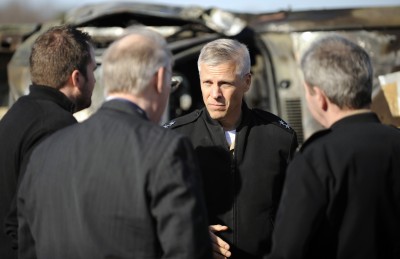
Rear Adm. Matthew Klunder, chief of naval research, talks with Dr. Clifford Bedford, Office of Naval Research's (ONR) energy conversion program officer, Capt. Michael Smith, right, commanding officer Naval Surface Warfare Center (NSWC) Dahlgren Division, and Jeb Brough, left, NSWC reactive materials lead, following an ONR High-Density Reactive Material (HDRM) demonstration held at NSWC Dahlgren's Pumpkin Neck test facility. HDRM has the strength of common aluminum alloys yet the density of mild steel, making it an ideal replacement for steel components in existing weapon systems. (U.S. Navy photo by John F. Williams/Released)
DAHLGREN, Va. - Military, government and industry officials watched the demonstration of a revolutionary material that increases the explosive force and lethality on enemy targets during a test at Naval Surface Warfare Center (NSWC) Dahlgren, Va., Dec. 2.
The test material, called High-Density Reactive Material (HDRM), is designed to replace steel in warhead casings with little or no compromise in strength or design.
"Today's test demonstrates this new material's potential and the ability of NAVSEA Warfare Center engineers and scientists to move it from the laboratory to full scale working prototype in under a year to meet technology development goals," said NSWC Dahlgren Division Commander Capt. Michael Smith. "It's a remarkable achievement that could not have been accomplished without close technical collaboration and effort between the Office of Naval Research (ONR), NSWC Dahlgren, NSWC Indian Head Division and industry."
Navy scientists and engineers from NSWC Indian Head Division (IHD) developed HDRM by combining several metals and using standard manufacturing processes.
"It's rewarding to see the validation of much of the theory and experimentation that led to the final material selection," said Dr. Clifford Bedford, ONR Advanced Energy Materials Program Manager. "In the applied research phase of the program, we've seen 100 percent reproducibility with this experimental system."
Unlike conventional munitions, the innovative materials approach integrates the casing with warhead explosives for increased lethality.
"HDRM has demonstrated enhanced blast, multiphase blast, and reactive fragments effects," said Dr. Jason Jouet, NSWC Indian Head Reactive Materials Team Lead. "With the strength of aluminum, density of steel, and more than one and a half times the energy of TNT, HDRM is truly a revolutionary enabling technology."
HDRM can readily replace steel in existing systems and is compatible with current warhead designs, thereby maintaining the same probability of a successful target strike.
"This approach may translate to less ordnance and ultimately fewer sorties to get the same result," said Jouet.
NSWC IHD's Reactive Materials Team has gradually scaled up its HDRM tests to gather measurable data on the materials destructive characteristics.
"Initially, small cylinder casings were tested to help us refine the design," said Bedford. "We used that data to fine-tune the parameters which were used to scale the charge in the later test demonstrations like the test conducted today."
NSWC Dahlgren engineers worked carefully with device characteristics provided by their NSWC Indian Head counterparts and with target characteristics to design a complex test arena at NSWC Dahlgren's Explosive Experimental Area.
"Rather than dynamically flying the HDRM ordnance device at a single target, we set up several tactically relevant targets," said Jeb Brough, NSWC Dahlgren Technical and Programmatic Lead for Reactive Materials. "We inspected damage to the targets and collected performance data that will be applied to effectiveness models for specific weapons."
Test instrumentation captured critical data and NSWC Dahlgren lethality engineers are currently assessing the target damage to judge the effects of the unique HDRM device.
"Although the arena is extremely complex, it is a cost effective method of evaluating the new material's capability and potential," said Brough. "With this data, the Office of Naval Research can evaluate the best potential for further development related to a specific weapon system."
Source: Naval Surface Warfare Center (NSWC) Dahlgren, Va.

